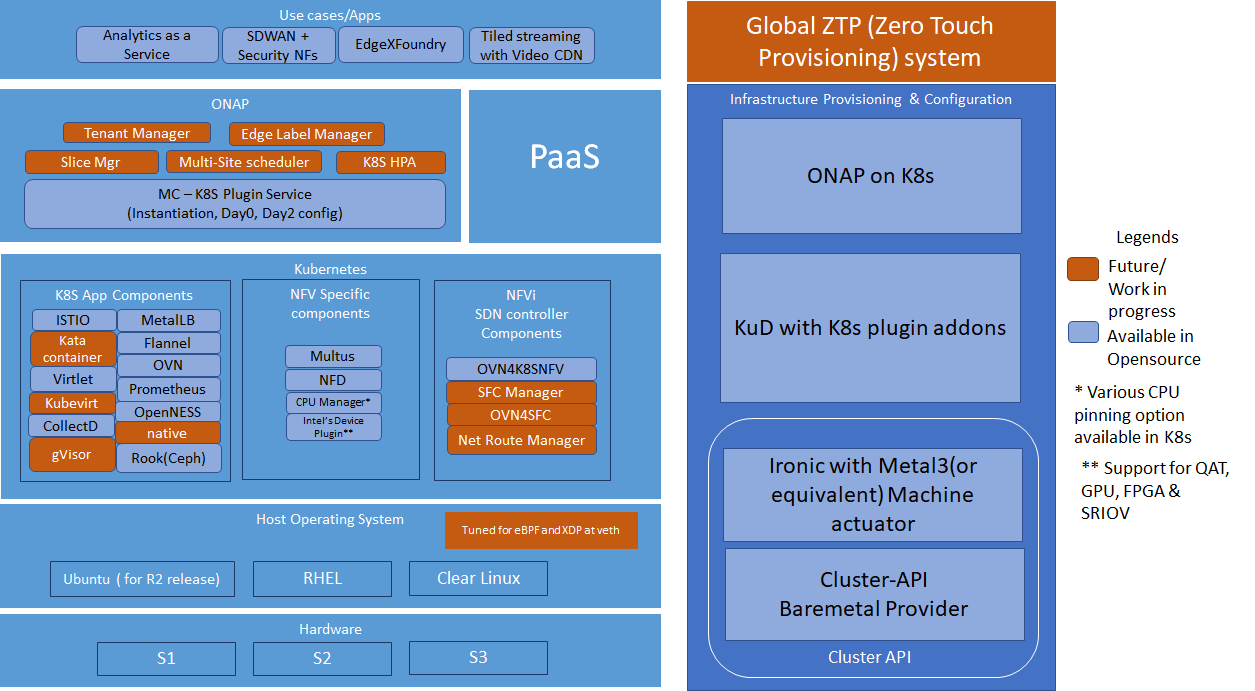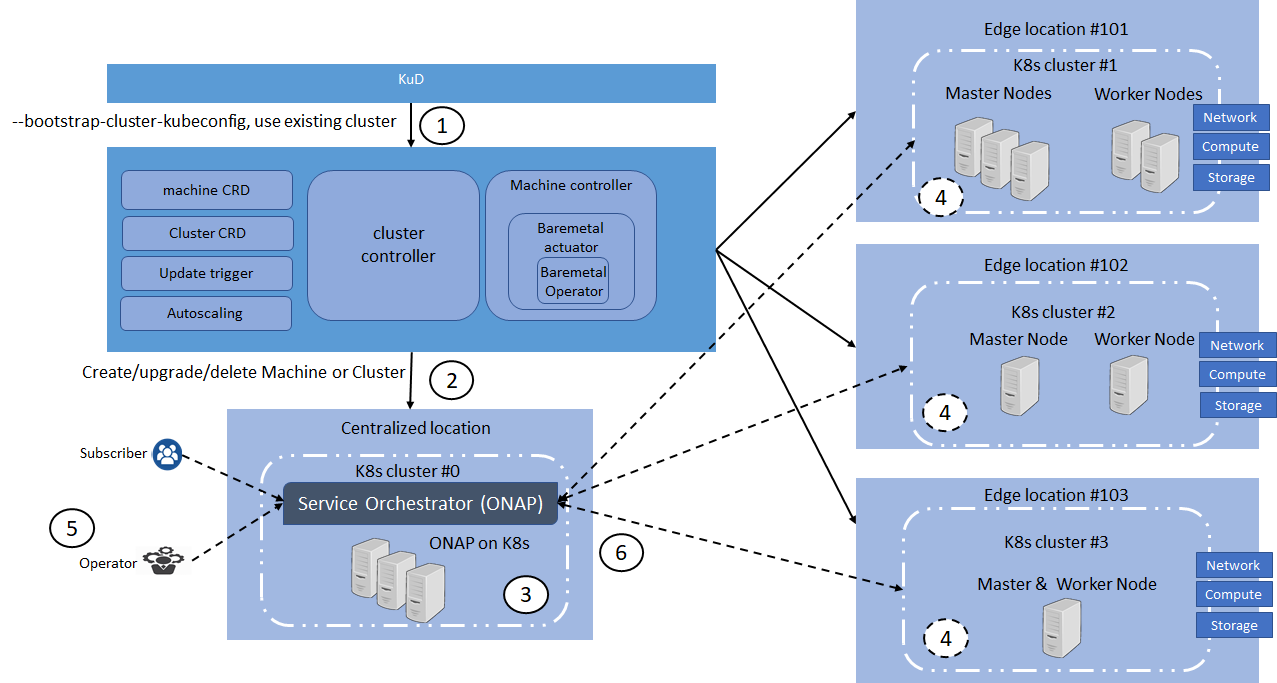ICN BP family intends to address deployment of workloads in a large number of edges and also in public clouds using K8S as resource orchestrator in each site and ONAP-K8S as service level orchestrator (across sites). ICN also intends to integrate infrastructure orchestration which is needed to bring up a site using bare-metal servers. Infrastructure orchestration, which is the focus of this page, needs to ensure that the infrastructure software required on edge servers is installed on per-site basis, but controlled from a central dashboard. Infrastructure orchestration is expected to do the following:
infra-global-controller: If infrastructure provisioning needs to controlled from a central location, this component is expected to be brought up in one location. This controller communicates with infra-local-controller (which is kind of agent) that perform the actual software installation/update/patch and provisions the software or BIOS etc...
infra-local-controller: Typically sits in each site in a bootstrap machine. Typically provided as bootable USB disk. It works in conjunction with the infra-global-controller. Note that, if there is no requirement to manage the software provisioning from a central location, then infra-global-controller is brought up along with the infra-local-controller.
User experience needs to be as simple as possible and even novice user shall be able to set up a site
Akraino's "Integrated Cloud Native NFV & App Stack" (ICN) Blueprint is a Cloud Native Compute and Network Framework(CN-CNF) to integrated NFV's application to the de-facto standard and setting a framework to address 5G, IOT and various Linux Foundation edge use case in Cloud Native.
ICN has ONAP as the Service Orchestration Engine(SOE) and the Cloud Native(CN) projects such as Kubernetes for Resource Orchestration Engine(ROE), Prometheus as the monitoring and alerting, OVN as the SDN controller, Container Network Interface(CNI) for Orchestration Networking, provides networking between the clusters, Envoy for Service proxy, Helm and Operators for package management and Rook for storage. The framework stack specifics the best configuration methodology, enables development projects, installation scripts, software package to bind CNCF and LF edge use cases together.
This document break downs the hardware requirements, software ingredient, Testing and benchmarking for the R2 and R3 release for and provides overall picture toward blue print effect in Edge use cases.

Global ZTP system is used for Infrastructure provisioning and configuration in ICN family. It is subdivided into 3 deployments Cluster-API, KuD and ONAP on K8s.
One of the major challenges to cloud admin managing multiple clusters in different edge location is coordinate control plane of each cluster configuration remotely, managing patches and updates/upgrades across multiple machines. Cluster-API provides declarative APIs to represent clusters and machines inside a cluster. Cluster-API provides the abstraction for various common logic that can be seen in various cluster provider such as GKE, AWS, Vsphere. Cluster-API consolidated all those logic provide abstractions for all those logic functions such as grouping machines for the upgrade, autoscaling mechanism.
In ICN family stack, Cluster-API Baremetal provider is metal3 Baremetal Operator, it is used as a machine actuator that uses Ironic to provide k8s API to manage the physical servers that also run Kubernetes clusters on bare metal host. Cluster-API manages the kubernetes control plane through cluster CRD, and Kubernetes node(host machine) through machine CRDs, Machineset CRDs and MachineDeployment CRDS. It also has an autoscaler mechanism that checks the Machineset CRD that is similar to the analogy of K8s replica set and MachineDeployment CRD similar to the analogy of K8s Deployment. MachineDeployment CRDs are used to update/upgrade of software drivers in
Cluster-API provider with Baremetal operator is used to provision physical server, and initiate the kubernetes cluster with user configuration
Kubernetes deployer(KUD) in ONAP can be reused to deploy the K8s App components(as shown in fig. II), NFV Specific components and NFVi SDN controller in the edge cluster. In R2 release KuD will be used to deploy the K8s addon such as Prometheus, Rook, Virlet, OVN, NFD, and Intel device plugins in the edge location(as shown in figure I). In R3 release, KuD will be evolved as "ICN Operator" to install all K8s addons.
One of the Kubernetes clusters with high availability, which is provisioned and configured by Cluster-API will be used to deploy ONAP on K8s. ICN family uses ONAP Operations Manager(OOM) to deploy ONAP installation. OOM provides a set of helm chart to be used to install ONAP on a K8s cluster. ICN family will create OOM installation and automate the ONAP installation once a kubernetes cluster is configured by cluster-API
ONAP will be the Service Orchestration Engine in ICN family and is responsible for the VNF life cycle management, tenant management and Tenant resource quota allocation and managing Resource Orchestration engine(ROE) to schedule VNF workloads with Multi-site scheduler awareness and Hardware Platform abstraction(HPA). Required an Akraino dashboard that sits on the top of ONAP to deploy the VNFs
Kubernetes will be the Resource Orchestration Engine in ICN family to manage Network, Storage and Compute resource for the VNF application. ICN family will be using multiple container runtimes as Virtlet, Kata container, Kubevirt and gVisor. Each release supports different container runtimes that are focused on use cases.
Kubernetes module is divided into 3 groups - K8s App components, NFV specific components and NFVi SDN controller components, all these components will be installed using KuD addons
K8s App components: This block has k8s storage plugins, container runtime, OVN for networking, Service proxy and Prometheus for monitoring, and responsible application management
NFV Specific components: This block is responsible for k8s compute management to support both software and hardware acceleration(include network acceleration) with CPU pinning and Device plugins such as QAT, FPGA, SRIOV & GPU.
SDN Controller components: This block is responsible for managing SDN controller and to provide additional features such as Service Function chaining(SFC) and Network Route manager.

Components | Link | Akraino Release target |
Cluster-API | R2 | |
Cluster-API-Provider-bare metal | R2 | |
Provision stack - Metal3 | R2 | |
Host Operating system | Ubuntu 18.04 | R2 |
Quick Access Technology(QAT) drivers | Intel® C627 Chipset - https://ark.intel.com/content/www/us/en/ark/products/97343/intel-c627-chipset.html | R3 |
NIC drivers | R3 | |
ONAP | Latest release 3.0.1-ONAP - https://github.com/onap/integration/ | R2 |
Workloads | OpenWRT SDWAN - https://openwrt.org/ | R3 |
KUD | R2 | |
Kubespray | R2 | |
K8s | R2 | |
Docker | https://github.com/docker - 18.09 | R2 |
Virtlet | R2 | |
SDN - OVN | 0.3.0 | R2 |
OpenvSwitch | R2 | |
Ansible | https://github.com/ansible/ansible - 2.7.10 | R2 |
Helm | https://github.com/helm/helm - 2.9.1 | R2 |
Istio | https://github.com/istio/istio - 1.0.3 | R2 |
Kata container | R3 | |
Kubevirt | https://github.com/kubevirt/kubevirt/ - v0.18.0 | R3 |
Collectd | R2 | |
Rook/Ceph | R3 | |
MetalLB | R3 | |
Kube - Prometheus | R3 | |
OpenNESS | Will be updated soon | R3 |
Multi-tenancy | R2 | |
Knative | R3 | |
Device Plugins | https://github.com/intel/intel-device-plugins-for-kubernetes - | R2 |
Node Feature Discovery | R2 | |
CNI | https://github.com/coreos/flannel/ - release tag v0.11.0 https://github.com/containernetworking/cni - release tag v0.7.0 https://github.com/containernetworking/plugins - release tag v0.8.1 https://github.com/containernetworking/cni#3rd-party-plugins - Multus v3.3tp, SRIOV CNI v2.0( withSRIOV Network Device plugin) | R2 |
Conformance Test for K8s | R2 |
| Release | Block | Components | Identified Gaps | Initial thought |
|---|---|---|---|---|
R2 | ZTP | Cluster-API | The cluster upgrade yet to be support | The definition of "cluster upgrade" and expected behaviour should be documented here. For example cluster upgrade could be kubelet version upgrade. |
| No node repair mechanism | Node logs such kubelet logs should be enable in the automation script | |||
| No Multi-Master support | Required to confirm from engineers | |||
| KuD | Virtlet , Multus, NFD & Istio | Installation script are in ansible and static. Required to be in daemonset | ||
| Virtlet & Intel Device plugin | Have to check with Virtlet support with device plugin framework | |||
| ONAP | OOM automation | Portal chart is deployed with loadbalancer with floating IP address | ||
| Dashboard | Monitoring tool to check the deployment across the multi site and show the metrics/statistics details to the operator | |||
| R3 | APP use cases | SDWAN | OpenWRT is potential candidate to configured SDWAN use case. Required more information on it |